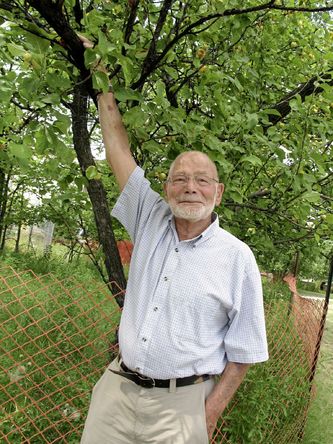
Yude Henteleff prepares to pick a crab apple from a tree planted by his grandfather 75 years ago at the site of his family’s former homestead that is now Henteleff Park. Image by Simon Fuller
The much-anticipated Interpretive Centre in Henteleff Park will mark its official opening with a public ceremony on Aug. 27 at 1 p.m. Everyone is invited.
For years, Yude Henteleff and the Henteleff Park Foundation have been working hard to create the centre, which is located near the park’s roadway entrance at 1964 St. Mary’s Rd. near the Henteleff family’s original homestead. The park is located along the banks of the Red River and Normand Creek in south St. Vital.
“When you’re in the park, you notice sometimes that you just see infinite shades of green,” Henteleff said.
According to Henteleff, the park is a place where natural beauty and rich historical traditions thrive in perfect harmony, as it preserves the rural character of a landscape that was significant to Manitoba’s early Métis culture, Winnipeg’s market garden industry and the Henteleff family.
The new centre will include a shelter building that will display panels of information that will lead to a new circular pathway with additional information panels, all-weather notebooks, new bench seating and landscaping.
“Historically, we’ve included elements that future generations should become aware of, understand and appreciate what the pioneers accomplished,” Henteleff, 89, said, noting the riparian forest in the area has unique characteristics pertaining to flora, fauna and birds.
“Also, of great importance is the history of the First Nations people, particularly the Métis people, as their roots here are very powerful, strong and important,” he added.
“We must also acknowledge all the back-breaking labour by the pioneers that came here from every part of Europe and elsewhere from places like Ukraine, Belgium, the Netherlands, the United Kingdom and Ireland. It was literally the United Nations. As well, the history of Jewish farmers in Manitoba has never been fully explained and the extent of their arrival in Manitoba was just enormous, especially in the Interlake. This is important because the general population doesn’t necessarily think of Jewish people as workers of the land, but coming to Canada and having the opportunity to own land was the most extraordinary happening for them.”
Henteleff’s roots St. Vital run significantly deep, as his grandfather and father homesteaded in what is now Henteleff Park in 1920-21 and became one of the larger market gardeners in this part of the city.
In 1924, the Henteleff family bought 40 acres of riverfront land and launched a thriving market garden operation in St. Vital. Nathan and Rose Henteleff and their family was among the first Jewish market gardeners in Western Canada. The family initially sold its produce from a roadside stand on St. Mary’s Road and later at the farmers’ market on Main Street and in small grocery stores in the city. Nathan and Rose lived and worked on the land until their retirement in 1967. The land was expropriated by the City in 2002 and designated as a public park in the family’s name.
He attended St. Germain School (now the site of a Shell station at 2146 St. Mary’s Rd.), which had all six grades in one classroom and most of the students were Métis: “Typically, for a country school, there was a wood stove, a water pump and an outdoor toilet. At the time, St. Vital was a separate municipality, so we lived very much a country life and cut ice on the Red River to store for the summer. The river was important for irrigation of crops and also a constant source of fun.”
Henteleff’s family emigrated from Chernigov in northern Ukraine in the early 1900s as they feared for their lives in their native land.
“Jews were just being murdered at the will of the larger population and my grandfather, Abraham Henteleff, decided if we didn’t leave, we would all be slaughtered, so the whole family emigrated to Canada to take up farming,” he said.
The Henteleff Park Foundation was formed in 2002 as a charitable organization and it consists of a dedicated city-wide network of volunteers who have worked tirelessly at the park. In the last 10 years, volunteers have planted more than 5,000 trees and shrubs, established trails measuring more than three kilometres, and raised funds to rehabilitate Normand Creek so it is now a successful spawning creek.
The foundation has been raising funds for the centre, in some shape or form, since it was established, which includes donations from private citizens stretching the length and breadth of the nation. Henteleff also acknowledges the assistance of the City of Winnipeg, Province of Manitoba, the Winnipeg Foundation and the Jewish Foundation of Manitoba, as well as the numerous volunteers along the way that have helped make the dream a reality.
“This a unique example of what volunteers can do working with different levels of government,” Henteleff said, noting there is a maintenance fund so “this part of the park will be looked after forever.”
In terms of the centre viewed as his own personal legacy, Henteleff said he has mixed feelings.
“I’m filled with two emotions. On one level, I’m very sad that my parents will not be here to bask in something that was important to them — their love of the land. Coming from a country that killed people just because they are Jewish to a place where there is justice and equality for all made so much difference to our lives and our destiny. But at the end of the day, it brings me great joy to see this finally happening,” he said.
“On another level, it’s wonderful that my four children and four great-grandchildren have been involved in the process. My son, Saul, is the president of the foundation’s board of directors and it’s wonderful to see succeeding generations taking over and carrying on. We want to make sure this will be here and available far into the future for people to learn about the past experiences of the pioneers. With every great achievement, there is always so much pleasure, but also a little sadness.”
simon.fuller@canstarnews.com
Facebook.com/TheLanceWPG
Twitter: @lanceWPG
Original Article: http://www.winnipegfreepress.com/our-communities/lance/Infinite-shades-of-green-390235062.html
